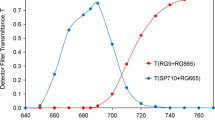Summary
-
1.
A method was developed for studying bioluminescent activity in single cells of the dinoflagellate,Pyrocystis fusiformis. Individuals were isolated in holding tubes in day phase and held without stimulation until bioluminescence was maximally excitable, between circadian time (CT) 14 and CT 22, where CT 0 designates daybreak. Mechanical stimulation, via a pulse generator controlled solenoid, was applied to individual cells that had received no prior excitation in the night phase tested.
-
2.
Two different flash forms were recorded. The first flash (FF) in response to a mechanical stimulus was very bright and had a rise time of 10 ms, and a biphasic decay that was 90% complete approximately 200 ms from flash onset. The form of subsequent flashes in response to further stimuli differed radically from the FF. They were dimmer and longer lasting than the FF with approximately 150 ms rise times and a monotonic decay that was 90% complete as long as 500 ms from flash onset.
-
3.
Cells responded with one flash per mechanical stimulus and recordings were made until the response was exhausted. Total mechanically stimulated luminescence (TMSL) was measured with a digital integrator. TMSL and the integral of the FF were functions of cell size.
-
4.
The degree of potentiation and number of flashes per cell were functions of stimulus frequency. At higher stimulus frequencies cells produced fewer flashes and more light per flash. The effects of potentiation were long lasting, persisting for stimulus intervals of up to one minute.
-
5.
At slow stimulus frequencies (one pulse per 48 s) bioluminescent activity was not totally exhausted during the 8 h night phase test period. With prolonged stimulation a fatigued flash form developed that combined elements of the FF and subsequent flashes.
-
6.
Cells that were stimulated to exhaustion recovered some bioluminescent capacity once stimulation ceased. Initial recovery was rapid and cells stimulated after only a 15 min recovery period produced as many flashes in the second stimulus series as in the first even though their TMSL was reduced 82%. Therefore, the number of flashes a cell produced was not simply proportional to the amount of bioluminescent material available.
-
7.
The unique FF kinetics recovered with time, requiring 30–60 min in unfatigued cells and more than 6 h in fatigued cells. With a 24 h recovery period FF kinetics were more dependent on the cell receiving a normal 12 h day phase than was TMSL recovery.
-
8.
Mechanically triggered bioluminescence inPyrocystis fusiformis appeared to be the result of at least two temporally distinct processes, one of which was dependent on a precharging period.
Similar content being viewed by others
Abbreviations
- CT :
-
circadian time
- d :
-
largest cell diameter
- FF :
-
first flash
- l :
-
length
- SRU :
-
stimulation and recording unit
- TMSL :
-
total mechanically stimulated luminescence
References
Biggley WH, Swift E, Buchanan RJ, Seliger HH (1969) Stimulable and spontaneous bioluminescence in the marine dinoflagellates,Pyrodinium bahamense, Gonyaulax polyedra andPyrocystis lunula. J Gen Physiol 54:96–122
Christianson R, Sweeney BM (1972) Sensitivity to stimulation, a component of the circadian rhythm in luminescence inGonyaulax. Plant Physiol 49:994–997
Eckert R (1965) Bioelectric control of bioluminescence in the dinoflagellateNoctiluca. Science 147:1140–1145
Eckert R (1966a) Subcellular sources of luminescence inNoctiluca. Science 151:349–352
Eckert R (1976b) Excitation and luminescence inNoctiluca miliaris. In: Johnson FH, Haneda Y (eds) Bioluminescence in progress. Princeton University Press, Princeton, New Jersey, pp 269–300
Eckert R (1967) The wave form of luminescence emitted byNoctiluca. J Gen Physiol 50:2211–2237
Eckert R, Reynolds GT (1967) The subcellular origin of bioluminescence inNoctiluca miliaris. J Gen Physiol 50:1429–1458
Eckert R, Sibaoka T (1968) The flash-triggering action potential of the luminescent dinoflagellateNoctiluca. J Gen Physiol 52:258–282
Esaias WE, CurlJr, HC, Seliger HH (1973) Action spectrum for a low intensity rapid photoinhibition of mechanically stimulable bioluminescence in the marine dinoflagellatesGonyaulax catenella, G. acatenella, andG. tamarensis. J Cell Physiol 82:363–372
Guillard RRL, Ryther JH (1962) Studies of marine planktonic diatoms. I.Cyclotella nana (Hustedt), andDetonula confervacea (Cleve) Gran. Can J Microbiol 8:229–239
Hamman JP, Seliger HH (1972) The mechanical triggering of bioluminescence in marine dinoflagellates: chemical basis. J Cell Physiol 80:397–408
Nawata T, Sibaoka T (1979) Coupling between action potential and bioluminescence inNoctiluca: effects of inorganic ions and pH in vacuolar sap. J Comp Physiol 134:137–149
Sweeney BM, Haxo FT, Hastings JW (1959) Action spectra for two effects of light on luminescence inGonyaulax polyedra. J Gen Physiol 43:285–299
Swift E, Durbin EG (1971) Similarities in the asexual reproduction of the oceanic dinoflagellates,Pyrocystis fusiformis, Pyrocystis lunula, andPyrocystis noctiluca. J Phycol 7:89–96
Swift E, Meunier V (1976) Effects of light intensity on division rate, Stimulable bioluminescence and cell size of the oceanic dinoflagellatesDissodinium lunula, Pyrocystis fusiformis andP. noctiluca. J Phycol 12:14–22
Swift E, Biggley WH, Seliger HH (1973) Species of oceanic dinoflagellates in the generaDissodinium andPyrocystis: interclonal and interspecific comparisons of the color and photon yield of bioluminescence. J Phycol 9:420–426
Zar JH (1974) Biostatistical analysis. Prentice-Hall, Englewood Cliffs, NJ
Author information
Authors and Affiliations
Additional information
We are grateful to Dr. B.M. Sweeney for invaluable advice and assistance, to Charles Anderson and Jeff Schweitzer for technical assistance and to Mark Lowenstine and Mark Rogers for electronics support. Our work was supported by the Office of Naval Research (ONR contract 8-488750-27017-3), Faculty Research Funds of the University of California and the FBN Fund.
Rights and permissions
About this article
Cite this article
Widder, E.A., Case, J.F. Two flash forms in the bioluminescent dinoflagellate,Pyrocystis fusiformis . J. Comp. Physiol. 143, 43–52 (1981). https://doi.org/10.1007/BF00606067
Accepted:
Issue Date:
DOI: https://doi.org/10.1007/BF00606067



